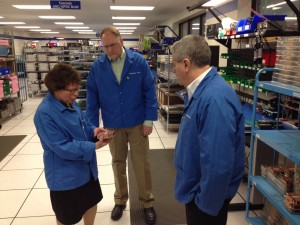The University of Wisconsin–Madison has been incredibly successful at scientific research over the years. We are always among the top recipients of federal research dollars. And you just have to browse our news clips from the past week to see a number of major scientific discoveries coming from UW researchers.
The fundamental work of science often advances through highly theoretical and basic research. Topics are often esoteric and journal articles can be read and understood by only a small community. While outsiders sometimes denigrate this sort of basic research, this highly theoretical and cutting-edge work often opens up whole new perspectives and – over time – leads to applied discoveries that change our lives and our world. Continuing to be major contributors to this sort of work is important to UW’s scientific contribution and to our research reputation.
But more applied work is important as well. I recently visited with the faculty in the Math Department, and they talked about the value of having both theoretical and applied mathematicians in the same department. And the Wisconsin Idea is a commitment to using the ideas and innovation from UW in ways that benefit the larger community around us.
For these reasons, I’ve been talking about the need to expand our partnership with the region and the state as an institution that is central to economic development. If we are to bring new business into the state/region and if we are to foster new and entrepreneurial efforts, UW needs to be involved as a partner, both educating skilled employees and consulting on the innovations that will attract and retain high technology companies.
So I’m very interested in fostering more business partnerships and in working more effectively on entrepreneurship and tech transfer programs. We can do a better job of commercializing the entrepreneurship already on campus, and transferring that technology to the private sector where appropriate, which is why we launched the D2P (Discovery to Product) initiative this past fall.
On Wednesday, I was in Chippewa Falls at Cray Inc.. Cray is the birthplace of the supercomputer and Chippewa Falls is the facility at which all Cray systems are built. Approximately 200 engineers work at the facility, and Cray is a strong recruiter of UW–Madison grads.
Cray also has a history of working with the UW on research. Most recently the company worked with Professor Tim Shedd from the College of Engineering on the development of liquid cooling technologies for the supercomputers they manufacture. The collaboration was the impetus for a startup, called Ebullient, which is covered by patents he’s assigned to the Wisconsin Alumni Research Foundation.
Cray spends more than $100 million annually on research and development, and I talked with their leadership about areas where we might collaborate, such as big data analytics and software architecture. They also talked about ways that Cray could increase their recruiting opportunities on campus. It was a fruitful conversation, and I hope we will be good partners in the future.
We’ve made some great strides in the last month, hiring people who can help us develop more connections with high-tech firms and industries. In February we hired Susan LaBelle, a veteran private sector executive and economic development leader, to lead our Office of Corporate Relations, which helps facilitate business partnerships. And just last week, we hired John Biondi, a Wisconsin entrepreneur with extensive experience in launching early-stage high-technology companies, as director of D2P.
I’m thrilled we were able to add these two talented and experienced business leaders to our team. They will be part of the effort to combine our strong basic science here at UW with innovative outreach and economic partnerships.
On a different topic: We’ve announced four finalists for provost, another very important position. Visits from the candidates begin on Monday, March 24, with all four candidates visiting that week. A schedule of the visits can be found here. I urge all members of the campus community to participate in this process.
